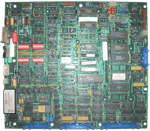 6CPP4 Processor Panel 6CPP4 Processor Panel
Description
The
6CPP6 processor is the latest processor offering from QEI. It has three
separate daughter board options to increase the communications
capabilities. The standard protocol for communications is QEI's
proprietary QUICS protocol. The processor can be purchased with any
number of protocol licenses and QEI can custom develop protocols if
necessary. The board can use QEI's proprietary digital input, analog
input, and control output boards and talk directly to those with three
separate I/O busses designed specifically for them. If those boards are
not used, then the I/O must be done through communicating with other
devices. This new processor board also has the added benefit of
communications status provided by the row of LEDs. These LEDs can be
seen at the top right of the picture above. The programming is done
completely through software provided by QEI. The DIP switches on the
6CPP6 are unlike those found on earlier processors. They are for more
specialized functions and rarely used. The 6CPP6 has the capability of
being backward compatible with previous QEI systems.
Communications
As
stated in the description, the board is capable of various types of
communications. The 6LAPX boards add additional communications paths,
but there are 3 on-board communications paths. Two use RS-232 and one
uses RS-485. Each of these is configurable by protocol. The RTU is
capable of communicating with two separate servers and an almost
unlimted amount of intelligent electronic devices (IEDs). These IEDs
range from voltage regulator controllers in electrical substations to
programmable logic controllers (PLCs) in water filtration
implementations.
Programming
All
programming is handled through the use of QEI's ConfigWizard software
package provided with each processor purchased. The software builds a
structured database of all the I/O and controls desired and allows each
individual point to be mapped back to the servers in any desired order.
It is also used to define the properties of the communications ports
such as what speed they will communicate at and what protocol they will
use. One additional communications port on the RTU allows the RTU to be
programmed or tested using on-board testing software built in to the
processor board. Additional programming software can be purchased to
allow the processor to perform on-board complex processing commands
such as Percent/Integral/Derivative (PID) functions important for many
industries including water/wastewater and gas utilities.
Accessories
As
mentioned above, there are special connectors for accesory boards which
add additional communications paths. One of the more important ones is
the 6NIA board allowing Ethernet communications and programming. With
the 6NIA board, the processor also adds a third speicial server
capability, which is a Web interface. |



